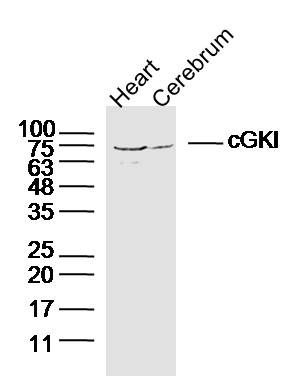购物车
全部删除  您的购物车当前为空
您的购物车当前为空
别名 PRKGR1B, PRKGR1A, PRKG1B, PRKG1, cGMP-Dependent Protein Kinase I, cGMP-Dependent Protein Kinase 1, cGKI, cGK1, cGK 1
Anti-PRKG1 Polyclonal Antibody 是一种 Rabbit 抗体,靶向 PRKG1。Anti-PRKG1 Polyclonal Antibody 可用于 ICC/IF,WB。
Anti-PRKG1 Polyclonal Antibody 是一种 Rabbit 抗体,靶向 PRKG1。Anti-PRKG1 Polyclonal Antibody 可用于 ICC/IF,WB。
| 规格 | 价格 | 库存 | 数量 |
|---|---|---|---|
| 50 μL | ¥ 1,170 | 5日内发货 | |
| 100 μL | ¥ 1,975 | 5日内发货 | |
| 200 μL | ¥ 2,785 | 5日内发货 |
| 产品描述 | Anti-PRKG1 Polyclonal Antibody is a Rabbit antibody targeting PRKG1. Anti-PRKG1 Polyclonal Antibody can be used in ICC/IF,WB. |
| 别名 | PRKGR1B, PRKGR1A, PRKG1B, PRKG1, cGMP-Dependent Protein Kinase I, cGMP-Dependent Protein Kinase 1, cGKI, cGK1, cGK 1 |
| Ig Type | IgG |
| 反应种属 | Human,Mouse,Rat (predicted:Chicken,Dog,Pig,Cow,Horse,Rabbit) |
| 验证活性 | 1. Sample: Hela Cell Lysate at 40 μg U2OS Cell Lysate at 40 μg Primary: Anti-cGKI (TMAB-01572) at 1/300 dilution Secondary: IRDye800CW Goat Anti-Rabbit IgG at 1/20000 dilution Predicted band size: 74 kDa Observed band size: 74 kDa 2. Sample: Heart (Mouse) Lysate at 40 μg Cerebrum (Mouse) Lysate at 40 μg Primary: Anti-cGKI (TMAB-01572) at 1/300 dilution Secondary: IRDye800CW Goat Anti-Rabbit IgG at 1/20000 dilution Predicted band size: 74 kDa Observed band size: 74 kDa 3. Hela cell; 4% Paraformaldehyde-fixed; Triton X-100 at room temperature for 20 min; Blocking buffer (normal goat serum) at 37°C for 20 min; Antibody incubation with (cGKI) polyclonal Antibody, Unconjugated (TMAB-01572) 1:25, 90 minutes at 37°C; followed by a conjugated Goat Anti-Rabbit IgG antibody at 37°C for 90 minutes, DAPI (blue) was used to stain the cell nucleus.    |
| 应用 | ICC/IFWB |
| 推荐剂量 | WB: 1:500-2000; ICC/IF: 1:100 |
| 抗体种类 | Polyclonal |
| 宿主来源 | Rabbit |
| 亚细胞定位 | Cytoplasm. Colocalized with TRPC7 in the plasma membrane. |
| 组织特异性 | Primarily expressed in lung and placenta. |
| 构建方式 | Polyclonal Antibody |
| 纯化方式 | Protein A purified |
| 性状 | Liquid |
| 缓冲液 | 0.01M TBS (pH7.4) with 1% BSA, 0.02% Proclin300 and 50% Glycerol. |
| 浓度 | 1 mg/mL |
| 研究背景 | Protein kinases are enzymes that transfer a phosphate group from a phosphate donor, generally the g phosphate of ATP, onto an acceptor amino acid in a substrate protein. By this basic mechanism, protein kinases mediate most of the signal transduction in eukaryotic cells, regulating cellular metabolism, transcription, cell cycle progression, cytoskeletal rearrangement and cell movement, apoptosis, and differentiation. With more than 500 gene products, the protein kinase family is one of the largest families of proteins in eukaryotes. The family has been classified in 8 major groups based on sequence comparison of their tyrosine (PTK) or serine/threonine (STK) kinase catalytic domains. PKG plays an important stimulatory role in platelet activation. |
| 免疫原 | KLH conjugated synthetic peptide: human Prkg1/cGKI |
| 抗原种属 | Human |
| 基因名称 | PRKG1 |
| 基因ID | |
| 蛋白名称 | cGMP-dependent protein kinase 1 |
| Uniprot ID | |
| 研究领域 | Platelets,Hypertrophy,Other Kinases |
| 功能 | Serine/threonine protein kinasethat acts as key mediator of the nitric oxide (NO)/cGMP signaling pathway. GMP binding activates PRKG1, which phosphorylates serines and threonines on many cellular proteins. Numerous protein targets for PRKG1 phosphorylation are implicated in modulating cellular calcium, but the contribution of each of these targets may vary substantially among cell types. Proteins that are phosphorylated by PRKG1 regulate platelet activation and adhesion, smooth muscle contraction, cardiac function, gene expression, feedback of the NO-signaling pathway, and other processes involved in several aspects of the CNS like axon guidance, hippocampal and cerebellar learning, circadian rhythm and nociception. Smoth muscle relaxation is mediated through lowering of intracellular free calcium, by desensitization of contractile proteins to calcium, and by decrease in the contractile state of smooth muscle or in platelet activation. Regulates intracellular calcium levels via several pathways: phosphorylates MRVI1/IRAG and inhibits IP3-induced Ca(2+) release from intracellular stores, phosphorylation of KCNMA1 (BKCa) channels decreases intracellular Ca(2+) levels, which leads to increased opening of this channel. PRKG1 phosphorylates the canonical transient receptor potential channel (TRPC) family which inactivates the associated inward calcium current. Another mode of action of NO/cGMP/PKGI signaling involves PKGI-mediated inactivation of the Ras homolog gene family member A (RhoA). Phosphorylation of RHOA by PRKG1 blocks the action of this protein in myriad processes: regulation of RHOA translocation; decreasing contraction; controlling vesicle trafficking, reduction of myosin light chain phosphorylation resulting in vasorelaxation. Activation of PRKG1 by NO signaling alters also gene expression in a number of tissues. In smooth muscle cells, increased cGMP and PRKG1 activity influence expression of smooth muscle-specific contractile proteins, levels of proteins in the NO/cGMP signaling pathway, down-regulation of the matrix proteins osteopontin and thrombospondin-1 to limit smooth muscle cell migration and phenotype. Regulates vasodilator-stimulated phosphoprotein (VASP) functions in platelets and smooth muscle. |
| 分子量 | Theoretical: 74 kDa. |
| 储存方式 | Store at -20°C or -80°C for 12 months. Avoid repeated freeze-thaw cycles. |
| 运输方式 | Shipping with blue ice. |
| 存储 | store at low temperature | store at -20°C |